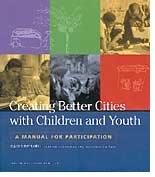

Children Design the Future
Three new reference books offer useful resources
by Megan M. Susman
AIA Program Manager, Livable Communities
AIA members and components across the country work with schools and youth groups to teach children about the design and planning of communities and buildings. Students learn the nuts and bolts of design and that their involvement can shape the way their communities grow. This early exposure to participating in design processes can help these children grow up to be involved, informed citizens.
Three recent publications also can be helpful to architects interested in involving children in community design. Half to three-quarters of all children in developed nations live in urban areas, and the same will soon be true of the developing world. These resources can help architects and others to engage urban youth in making their cities positive places to grow up.
 The
importance of “hanging out”
The
importance of “hanging out”
UNESCO published a pair of books through its “Growing
Up in Cities” project, which involves young people in evaluating
and changing the urban environments in which they live. Creating
Better Cities With Children and Youth: A Manual for Participation,
by David Driskell, offers a detailed how-to guide to tapping the energy
and ideas of young residents of cities in a meaningful way. The techniques
have been field-tested in cities all over the world. An extensive list
of resources on public participation processes and working with children
appears at the back of the book.
The book lays out the arguments for involving children in design and planning, not the least of which are that children are particularly vulnerable to environmental threats and have a legitimate right to add their voice to development discussions. “Places that are better for young people are better for everyone,” Driskell points out.
The book uses worksheets, check lists, case studies, simple flow charts, and other user-friendly tools to make the process accessible even to people with little or no experience in public participation processes—or with children. It suggests exercises for children of various age levels and gives detailed guidelines on basic participatory methods, including informal observation, interviews, drawing, activity schedules, family and support networks, role-play and puppetry, guided tours, photographs by young people, behavior mapping, questionnaires and surveys, focus groups and small-group discussions, and workshops and community events. Each method’s section includes the purpose of the technique, the time and materials required, ideas for maximizing the children’s participation, and a guide to the process, along with vignettes and photos from projects on every continent except Antarctica.
Driskell offers advice on dealing with young people, including treating them with respect, establishing trust, expressing appreciation to them, and developing a rapport. He is a great proponent of “hanging out,” spending time with the children outside of the structured participation process. He describes the experience of one adult in India whose “hanging out” time with the local boys led to their showing him their “secret places,” which they had not mentioned to the adults and were important to their play and independence from parents. “This information—and many of the insights that followed—might have remained undiscovered without the time spent ‘just hanging out,’” Driskell notes.
 Poignant
case studies
Poignant
case studies
A companion book, Growing Up in an Urbanising
World, edited by Louise Chawla, was written by an interdisciplinary
team of child-environment experts from design and social sciences professions.
This publication is more academic, describing the creation and goals of
the “Growing Up in Cities” project and presenting in-depth
analyses of projects in Argentina, Australia, India, Norway, Poland, South
Africa, the United Kingdom, and the U.S. The case studies are engagingly
written and often moving: children in a low-income apartment complex in
Oakland, Calif., wistfully hope that in 10 years they’ll be living
“somewhere else—somewhere safe, somewhere pretty that I could
afford.” Children in a relatively old and poor section of Buenos
Aires take great pride in their neighborhood yet are clear-eyed about
its negative aspects. A group of children in a squatter camp in Johannesburg
voice their concerns as their camp is being forcibly relocated. The lessons
teased out of each project are summarized in a concluding chapter that
offers recommendations for involving children in making their environments
more livable.
 A
good starter book
A
good starter book
The California Center for Civic Participation has just released the Youth
Voices in Community Design Handbook: A How-to Guide for Adults on Involving
Youth in Community Planning. This publication is much less detailed
than Creating Better Cities With Children
and Youth, offering suggestions on activities but little in-depth
guidance on conducting them, but it is perhaps a more accessible introduction
to engaging young people in community design decisions. It is supplemented
by a library of resources for students and facilitators on the
California Center’s Web site, and the California Center staff
offer personal technical assistance as well. The booklet includes eight
brief case studies, with links to more information, and promises more
case studies will be posted on its Web site.
Copyright 2004 The American Institute of Architects.
All rights reserved. Home Page ![]()
![]()
